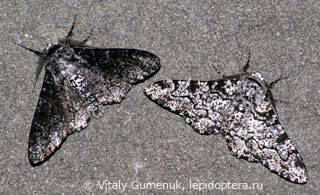Peppered moth is an accurate example of natural selection
Community and Forum → Blog → Peppered moth is an accurate example of natural selection
Lev Bely, 10.03.2012 23:37

The darkening of the peppered moth (Biston betularia) often met in school textbooks as a case study for adaptation, was confirmed as an accurate example of natural selection, according to a study made by a biologist of the Harvard university together with other scientists.
During the Industrial Revolution, English scientists noticed that peppered moths became getting darker and the number of dark ones increased. Then they supposed that moths got darker after trees got covered with soot. In the last decades of the 19th century air became cleaner and lighter colored moths thereafter increased.
During the 1980s and 1990s this idea yet aroused new disputes in scientific circles, according to the paper’s co-author James Mallet, a lecturer in Organismic and Evolutionary Biology. “It was just too good of a story, so scientists began looking for possible problems with it,” Mallet said.
Michael Majerus, a professor at University of Cambridge was one of the first researchers who raised these concerns and eventually finished this debate between uomini illustri. As Mallet's paper reads, Majerus set out on a six-year project to conduct experiments and make observations to improve on the previous work. The data he got helped scientists to evaluate the evolution of peppered moths.
“Majerus felt some of the experiments hadn’t been very well done, though he believed natural selection was the main factor that explained the change in color of peppered moths,” Mallet said.
Majerus let moths out so that they could land freely not only on the tree trunk, but also on its branches and twigs. According to the study, he also released them in smaller numbers and at night.
“The peppered moth experiment is the biggest of its type,” Mallet said. “It was done in the most careful way that Michael Majerus, who is really an expert on the moths, could devise — and therefore it answers many of the possible criticisms that he and others had on the previous experiments.”
Mallet together with three other professors from British universities used the results of Majerus' work to write this paper that finally confirmed the original idea which has been long time just supposed.
“With this new evidence added to the existing data, it is virtually impossible to escape the previously accepted conclusion that visual predation by birds is the major cause of rapid changes in frequency of melanic [dark] peppered moths,” the study reported.
The Harvard Crimson, http://www.thecrimson.com
Photo: Vitaly Gumenyuk, http://lepidoptera.pro
All the rest posts on: UK, science, ecology
Comments
New comment
Note: you should have a Insecta.pro account to upload new topics and comments. Please, create an account or log in to add comments.
* Our website is multilingual. Some comments have been translated from other languages.
Random species of the website catalog
News
- 02.03.2025: Moscow Insect Fair: New section on the Insecta.pro Website
- 31.12.2024: If you need to upload a lot of photos to Insecta.pro website
- 10.12.2024: Новое поле в «Поиске энтомологов»
New photos (25.03.2025)
Fresh from the community
- 12:52, L. Bolshakov: Петр, см. там подробности: https://...
- 12:32, P. Khramov: Лавр, источник скиньте, пожалуйста....
- 23:33, L. Bolshakov: К сожалению, вы поступили неверно. ...
Popular insects
Recommended blog topics
- ICZN Election of Commissioners
- 20th International Insect Fair in Moscow (Russia, October 2023)
- The petition in defense of biological nomenclature
- Diamondback moths are sterilized to reduce crop loss



























